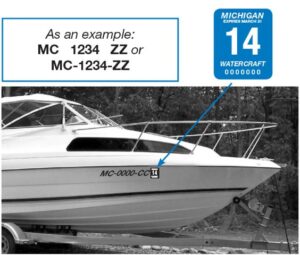There are two important parts to Michigan MC registration number placement and installation:
- Proper placement to comply with watercraft registration laws
- Installing the stickers
1. Placement of Michigan MC Registration Numbers
The following information from the guide to Michigan MC number sticker placement can be found on the State of Michigan web site.
Watercraft Registration Number:
Watercraft owners must paint or permanently attach the assigned registration number on each side of the forward half of the vessel as high above the water line as possible. The number must contrast with the color of the background so it is visible and legible.
All letters and numbers must be plain block characters at least 3 inches high, reading from left to right. Place a hyphen or leave space equivalent to the width of your letter “M” between the letters and numbers.

Registration Decal
The three-year watercraft registration decals must be attached to the forward half of the vessel on the same level as the registration number. Place each decal 3 inches to the right of the last letter in the registration number, reading left to right, on both sides of the vessel.


Documented Vessels
On a vessel documented by the U.S. Coast Guard, the registration number does not have to be displayed. However, one registration decal must be attached to each side of the forward half of the vessel as high above the water line as possible.
2. Installing your stickers from Michigan-MC-Numbers.com
To ensure that your stickers will adhere properly to your boat, please follow these instructions carefully:
Check out our 3 minute video in which we install a set of Michigan MC Numbers on a Boston Whaler.
- Clean the area of the boat hull where the numbers are to be applied. Make sure all oil, grease, wax or other surface contaminants are removed. Acetone is recommended, but glass cleaner can also be used.
- For best results, apply where both the vinyl and hull can be above 50 degrees F. At cold temperatures, the vinyl can become brittle, and the adhesive characteristics of both the vinyl and the transfer tape also change.
- Use a horizontal rule to mark a baseline for where you will apply the vinyl. A small tick mark at the end points and every 12” is helpful. A fine point felt tip marker or sharpie (ink can be removed with acetone from non-porous surfaces) is helpful.
- Peel back about 1/2” of the transfer tape (but not the vinyl itself) and fold the substrate back on itself vertically.
- Position the bottom of the letters against your baseline.
- When you are satisfied with your positioning, press the “tab” of transfer tape onto the boat.
- Slowly peel the transfer tape from substrate using a 180 degree motion. The vinyl should be picked up on the transfer tape.
- Work your way along the graphics, slowly peeling the substrate and then lightly pressing the transfer tape/vinyl onto the hull as you expose more of substrate. Be careful not to pull to hard or the vinyl may stretch and distort.
- With the vinyl and transfer tape in position, use a plastic spatula or old credit card (never one that you’ll need again!) to burnish the vinyl onto the hull. You’ll want to use fairly aggressive pressure, but not too much to rip through the tape.
- Slowly peel up the transfer tape. If you have started from a clean surface and burnished well, the vinyl will adhere and the transfer tape will come up.
If you have a STENCIL product:
You’ve got one more step – once your stencil is down on your boat, protect the rest of the boat from overspray with newspaper or cardboard; you will be spray painting your stencil “holes” – that match the typeface and your custom numbers! If you have a rigid inflatable, see this article here for a customer-recommended product. If you’re applying to a roto molded plastic hull, use a recommended plastic spray paint from the manufacturer of your kayak or boat. With each order, we include 2 stencils so you can set them up on your boat and spray both in succession.
Alternative installation: the “Wet” method (do NOT use this for stencils)
You may also install these using the wet method. See our video below for details on the wet method.
- Clean the area of the boat hull where the numbers are to be applied. Make sure all oil, grease, wax or other surface contaminants are removed. Acetone is recommended, but glass cleaner can also be used.
- For best results, apply where both the vinyl and hull can be above 50 degrees F. At cold temperatures, the vinyl can become brittle, and the adhesive characteristics of both the vinyl and the transfer tape also change.
- Use a horizontal rule to mark a baseline for where you will apply the vinyl. A small tick mark at the end points and every 12” is helpful. A fine point felt tip marker or sharpie (ink can be removed with acetone from non-porous surfaces) is helpful.
- Make up a spray bottle of water with a little bit of dish soap and shake (mostly water, a tiny bit of soap, just to get it to bubble a little bit). The dish soap and water help create a slick surface for the vinyl to slide on for application that can be moved around while applying.
- Peel the PAPER backing off, exposing the sticky side of the vinyl and transfer paper
- Spray the transfer paper and vinyl lightly with the soapy solution
- Apply to your hull. You have a minute to adjust this because the graphics will slide on your hull with the wet method.
- Burnish with something flat/plastic (a ruler, an old credit card or loyalty card, a spatula)
- Peel the transfer tape off
- That’s it! Easy!

